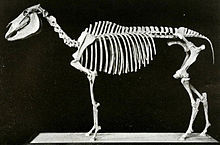
Equidae is the taxonomic family of horses and related animals, including the extant horses, asses, and zebras, and many other species known only from fossils. The family evolved around 50 million years ago from a small, multi-toed ungulate into larger, single-toed animals. All extant species are in the genus Equus, which originated in North America. Equidae belongs to the order Perissodactyla, which includes the extant tapirs and rhinoceros, and several extinct families.

A mastodon is a member of the genus Mammut, which strictly defined, was endemic to North America and lived from the late Miocene to the early Holocene. Mastodons belong to the order Proboscidea, the same order as elephants and mammoths. Mammut is the type genus of the extinct family Mammutidae, which diverged from the ancestors of modern elephants at least 27-25 million years ago, during the Oligocene.
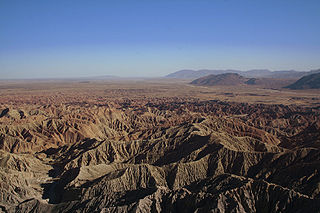
Anza-Borrego Desert State Park is a California State Park located within the Colorado Desert of southern California, United States. The park takes its name from 18th century Spanish explorer Juan Bautista de Anza and borrego, a Spanish word for sheep. With 585,930 acres (237,120 ha) that includes one-fifth of San Diego County, it is the largest state park in California and the second biggest park nationally.
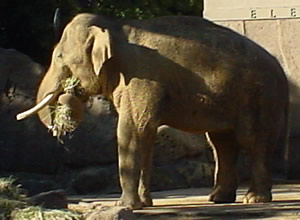
Elephas is one of two surviving genera in the family of elephants, Elephantidae, with one surviving species, the Asian elephant, Elephas maximus. Several extinct species have been identified as belonging to the genus, extending back to the Pliocene era.
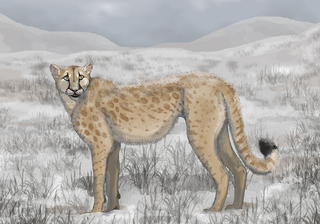
Miracinonyx is an extinct genus of felids belonging to the subfamily Felinae that was endemic to North America from the Pleistocene epoch and morphologically similar to the modern cheetah, although its apparent similar ecological niches have been considered questionable due to anatomical morphologies of the former that would have limited the ability to act as a specialized pursuit predator. The genus was originally known from fragments of skeletons, but nearly complete skeletons have been recovered from Natural Trap Cave in northern Wyoming.

Camelops is an extinct genus of camels that lived in North and Central America, ranging from Alaska to Honduras, from the middle Pliocene to the end of the Pleistocene. It is more closely related to the Old World dromedary and bactrian and wild bactrian camels than to the New World guanaco, vicuña, alpaca and llama; making it a true camel of the Camelini tribe. Its name is derived from the Ancient Greek κάμηλος and ὄψ, i.e. "camel-face".

Equus lambei, commonly known as the Yukon horse or Yukon wild horse, is an extinct species of the genus Equus. Equus lambei ranged across North America until approximately 10,000 years ago. Based on recent examinations of the mtDNA of Equus lambei remains, scientists have concluded that E. lambei was probably much like the extinct tarpan, also known as the Eurasian wild horse, and the living Przewalski's horse. A partial carcass of Equus lambei is on display at the Yukon Beringia Interpretive Centre in Whitehorse, Yukon.
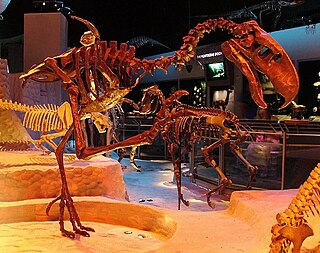
Titanis is a genus of phorusrhacid, an extinct family of large, predatory birds, in the order Cariamiformes that inhabited the United States during the Pliocene and earliest Pleistocene. The first fossils were unearthed by amateur archaeologists Benjamin Waller and Robert Allen from the Santa Fe River in Florida and were named Titanis walleri by ornithologist Pierce Brodkorb in 1963, the species name honoring Waller. The holotype material is fragmentary, consisting of only an incomplete right tarsometatarsus and phalanx, but comes from one of the largest phorusrhacid individuals known. In the years following the description, many more isolated elements have been unearthed from sites from other areas of Florida, Texas, and California. It was classified in the subfamily Phorusrhacinae, which includes some of the last and largest phorusrhacids like Devincenzia and Kelenken.

Hippidion is an extinct genus of equine that lived in South America from the Late Pliocene to the end of the Late Pleistocene (Lujanian), between 2.5 million and 11,000 years ago. They were one of two lineages of equines native to South America during the Pleistocene epoch, alongside Equus (Amerhippus) neogeus.
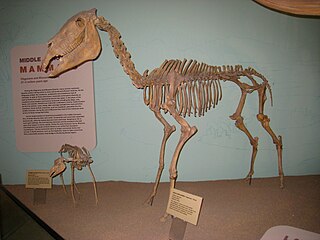
Equus simplicidens, sometimes known as the Hagerman horse or the American Zebra is an extinct species of equine native to North America during the Pliocene and Early-Late Pleistocene. It is one of the oldest and most primitive members of the genus Equus. Abundant remains of it were discovered in 1928 in Hagerman, Idaho. It is the state fossil of Idaho.

Tremarctos floridanus, occasionally called the Florida spectacled bear, Florida cave bear, or rarely Florida short-faced bear, is an extinct species of bear in the family Ursidae, subfamily Tremarctinae. T. floridanus was widespread in the Southeastern United States during the Rancholabrean epoch, with scattered reports of fossils from other parts of North America and from earlier epochs.

Haringtonhippus is an extinct genus of equine from the Pleistocene of North America The genus is monospecific, consisting of the species H. francisci, initially described in 1915 by Oliver Perry Hay as Equus francisci. Members of the genus are often referred to as stilt-legged horses, in reference to their slender distal limb bones, in contrast with those of contemporary "stout legged" caballine true horses.
Equus alaskae was a Pleistocene species of horse, now extinct, that inhabited North America.
Equus semplicatus was a Pleistocene species of New World stilt-legged horse, and considered the type species for the stilt legged horses, one of three lineages of equids within the Americas, the other two being hippidionid and caballine horses. Now extinct, Equus semiplicatus once inhabited North America.
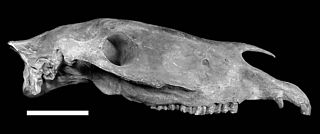
Equus neogeus is an extinct species of equine native to South America during the Pleistocene. It was formerly thought to be several distinct species within the subgenus Amerhippus, but was later shown to be a single morphologically variable species. It is thought to be closely related to true horses.

James Williams Gidley (1866-1931) was an American paleontologist and museum curator.
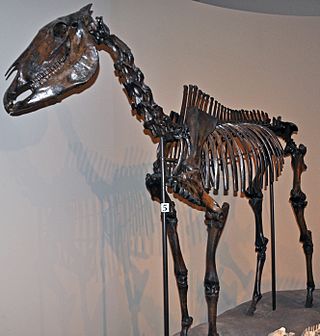
Equus occidentalis is an extinct species of wild horse that once inhabited North America, specifically the Southwestern United States, during the Pleistocene epoch. It was first described from three teeth with insufficient diagnostic characters, one even being suggested to be a separate taxon related to the American Zebra, leading some researchers to consider it a nomen dubium, though this taxonomic debate is yet to be fully resolved.
The Palm Spring Formation is a Pleistocene Epoch geologic formation in the eastern Colorado Desert of Imperial County and San Diego County County, Southern California.
The giant horse is an extinct species of horse which lived in North America.
Equus niobrarensis is an extinct species of Equus, the genus that includes the horse. E. niobrarensis may be synonymous with Equus scotti. It was "stout-legged" and belonged to the "big horses" category as defined by M. C. Winans. The skull of the horse was noted as being broader than Equus caballus.
